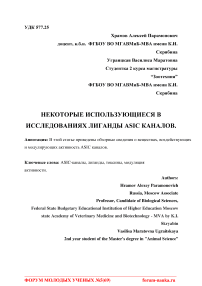Некоторые использующиеся в исследованиях лиганды ASIC каналов
Автор: Храмов А.П., Уграицкая В.М.
Журнал: Форум молодых ученых @forum-nauka
Статья в выпуске: 5 (69), 2022 года.
Бесплатный доступ
В этой статье приведены обзорные сведения о веществах, воздействующих и модулирующих активность ASIC каналов.
Asic-каналы, лиганды, токсины, модуляция активности
Короткий адрес: https://sciup.org/140293199
IDR: 140293199
Список литературы Некоторые использующиеся в исследованиях лиганды ASIC каналов
- Baron, A., Diochot, S., Salinas, M., Deval, E., Noël, J., Lingueglia, E., 2013. Venom toxins in the exploration of molecular, physiological and pathophysiological functions of acid-sensing ion channels. Toxicon 75, 187-204.
- Bohlen, C. J., Priel, A., Zhou, S., King, D., Siemens, J., Julius, D., 2010. A bivalent tarantula toxin activates the capsaicin receptor, TRPV1, by targeting the outer pore domain. Cell 141, 834-845
- Chagot, B., Escoubas, P., Diochot, S., Bernard, C., Lazdunski, M., Darbon, H., 2005. Solution structure of APETx2, a specific peptide inhibitor of ASIC3 proton-gated channels. Protein Sci. 14, 2003-2010 ;
- Chassagnon, I. R., McCarthy, C. A., Chin, Y. K., Pineda, S. S., Keramidas, A., Mobli, M., Pham, V., De Silva, T. M., Lynch, J. W., Widdop, R. E., Rash, L. D., King, G. F., 2017.
- Cristofori-Armstrong, B., & Rash, L. D. (2017). Acid-sensing ion channel (ASIC) structure and function: Insights from spider, snake and sea anemone venoms. Neuropharmacology, 127, 173–184. doi:10.1016/j.neuropharm.2017.
- Delaunay, A., Gasull, X., Salinas, M., Noel, J., Friend, V., Lingueglia, E., Deval, E., 2012. Human ASIC3 channel dynamically adapts its activity to sense the extracellular pH in both acidic and alkaline directions. Proc. Natl. Acad. Sci. USA 109, 13124-13129.
- Deval, E., Noël, J., Gasull, X., Delaunay, A., Alloui, A., Friend, V., Eschalier, A., Lazdunski, M., Lingueglia, E., 2011. Acid-sensing ion channels in postoperative pain. J. Neurosci. 31, 6059-6066.
- Diochot, S., Baron, A., Rash, L. D., Deval, E., Escoubas, P., Scarzello, S., Salinas, M., Lazdunski, M., 2004. A new sea anemone peptide, APETx2, inhibits ASIC3, a major acid- sensitive channel in sensory neurons. EMBO J. 23, 1516-1525.
- Escoubas P, Bernard C, Lambeau G, Lazdunski M, Darbon H (July 2003). "Recombinant production and solution structure of PcTx1, the specific peptide inhibitor of ASIC1a proton-gated cation channels". Protein Science. 12 (7): 1332–43. doi:10.1110/ps.0307003. PMC 2323924. PMID 12824480.
- Escoubas P, De Weille JR, Lecoq A, Diochot S, Waldmann R, Champigny G, Moinier D, Ménez A, Lazdunski M (August 2000). "Isolation of a tarantula toxin specific for a class of proton-gated Na+ channels". The Journal of Biological Chemistry. 275 (33): 25116–21.
- Jensen, J. E., Cristofori-Armstrong, B., Anangi, R., Rosengren, K. J., Lau, C. H., Mobli, M., Brust, A., Alewood, P. F., King, G. F., Rash, L. D., 2014. Understanding the molecular basis of toxin promiscuity: the analgesic sea anemone peptide APETx2 interacts with acid-sensing ion channel 3 and hERG channels via overlapping pharmacophores. J. Med. Chem. 57, 9195-9203
Статья научная


